Step by step, students learn more about doctoring
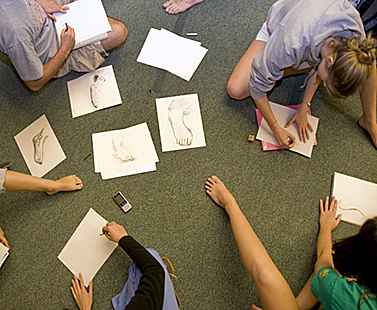
When we are strong, they march us to victory. We put our best one forward or get one in the door. We are sure-footed.
They tell the world our moods: energized in Air Nike, sexy in Manolos, relaxed in flip-flops.
And yet our feet are somehow vulnerable. When we are weak, we are trampled underfoot. We get off on the wrong one or put one in our mouth. If things are especially bad, we might even have one in the grave.
All of which, perhaps, explains the ripple of nervous laughter in the classroom of Lois LaCivita Nixon, PhD, this week when her first-year students in the USF College of Medicine learned they were about to show the world their naked feet.
Or, if not the world, even worse: their classmates.
It was the culmination of an unusual assignment for the “On Doctoring” class that Dr. Nixon directs. Dr. Nixon first assigned the students a series of readings. They included everything from a poem about aging feet to an essay about the power of touch between physician and patient. Not until students arrived in class did they learn they would be drawing feet. First they tackled those of fellow faculty members and students. Next, each other’s.
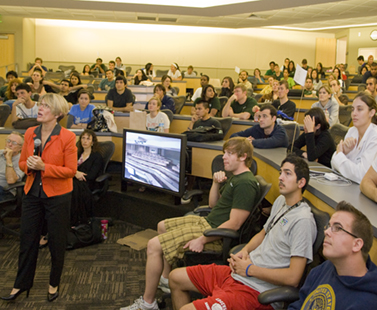
“You’re going to tell a story,” Dr. Nixon told them, “And you’re going to learn a story about somebody’s foot.”
Soon Dr. Marion Ridley was stripping off one black sock and polished shoe and revealing a family secret.
“Everybody in my family has one of these – a knot on the first metatarsal,” he told the students clustered around him. “We call it the Ridley bone.”
All around the room, similar tales unfolded.
Dr. Frazier Stevenson, associate dean of undergraduate medical education, broke his ankle backpacking in the California mountains. He was carried out on a stretcher and his foot still bears the scars. Klaus Herdocia, USF Health art director, told students that the nail on his third right toe grew in after he was born. Student Kristina Chechotka’s second toes curve inward so much that her parents teased her about it when she was small. Dr. Ridley, a professor of otolaryngology, dropped a box on his left foot last week.
“I’m not used to disrobing in front of medical students,” Dr. Ridley joked. “But I guess I can go this far.”
He watched the students’ initial nervousness with approval.
“You’ve got to get across the threshold of discomfort to draw someone’s foot,” Dr. Ridley said.
Students need to learn how to deal with that queasiness without letting it cloud their judgment or actions, he said.
“Being able to deal with an uncomfortable situation is part of being a physician,” he said. “You never know what a patient is going to say. Getting out of your comfort zone is part of the maturation process.”
As Dr. Ridley sat with his foot outstretched, students clustered around him, charcoals in hand. Some added subtle shadings; others lacked any sense of depth or perspective. But artistic talent didn’t really matter; their intense focus did.
“I love it,” said Aaron Block. “I had no idea coming to medical school that they would care about how we think about things artistically, and as human beings.”
In his other classes, Block said, the foot is a structure of bones and muscles.
“This is much more holistic,” he said. “You have to think about the story within the body part.”
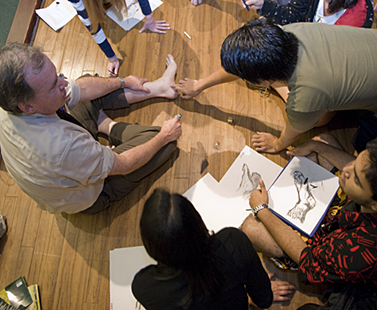
He pointed to the poem the group read, about a man’s frustrated inability to care for his feet as he gained weight.
“It makes you think about how little things can contribute to an overall decline in quality of life,” he said.
It’s those kinds of questions that Dr. Nixon wants her students to ask. This is the first year they’ve drawn feet; in the past she’s taken them to museums and even to the opera. She tries to time such lessons to coordinate with what they’re learning in their basic science classes, tackling similar subjects from a different perspective.
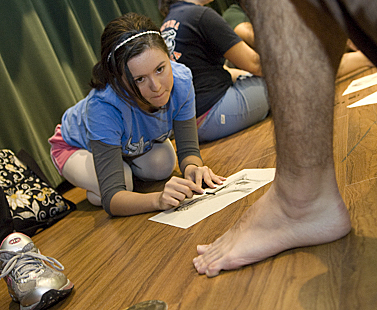
“I try to find things to do out of the classroom,” she said. “To set aside the things they’re memorizing in science and set them wondering.”
After having her feet drawn, Kristina Chechotka, the student with the curving toes, found herself wondering about the nature of vulnerability and exposure. Wondering what it’s like to, well, walk in her patient’s shoes.
“Even the simplest body parts can feel awkward,” Chechotka said. “So think how sensitive showing something more private is. It gives you an appreciation of that self-conscious feeling.”
Having others draw her feet – especially after a classmate jokingly dubbed her “Snaggletoe” – made her think about why patients surrender privacy and endure discomfort.
“We really, as physicians, are privileged, because we’re let into the private part of patients’ lives,” she said. “They trust us enough to show us these things.”
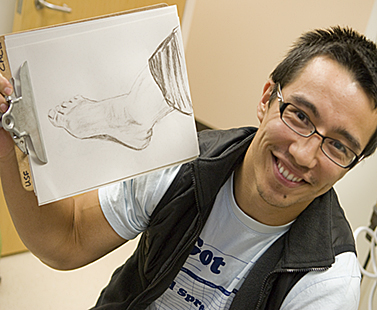
– Story by Lisa Greene, photos by Eric Younghans, USF Health Communications

